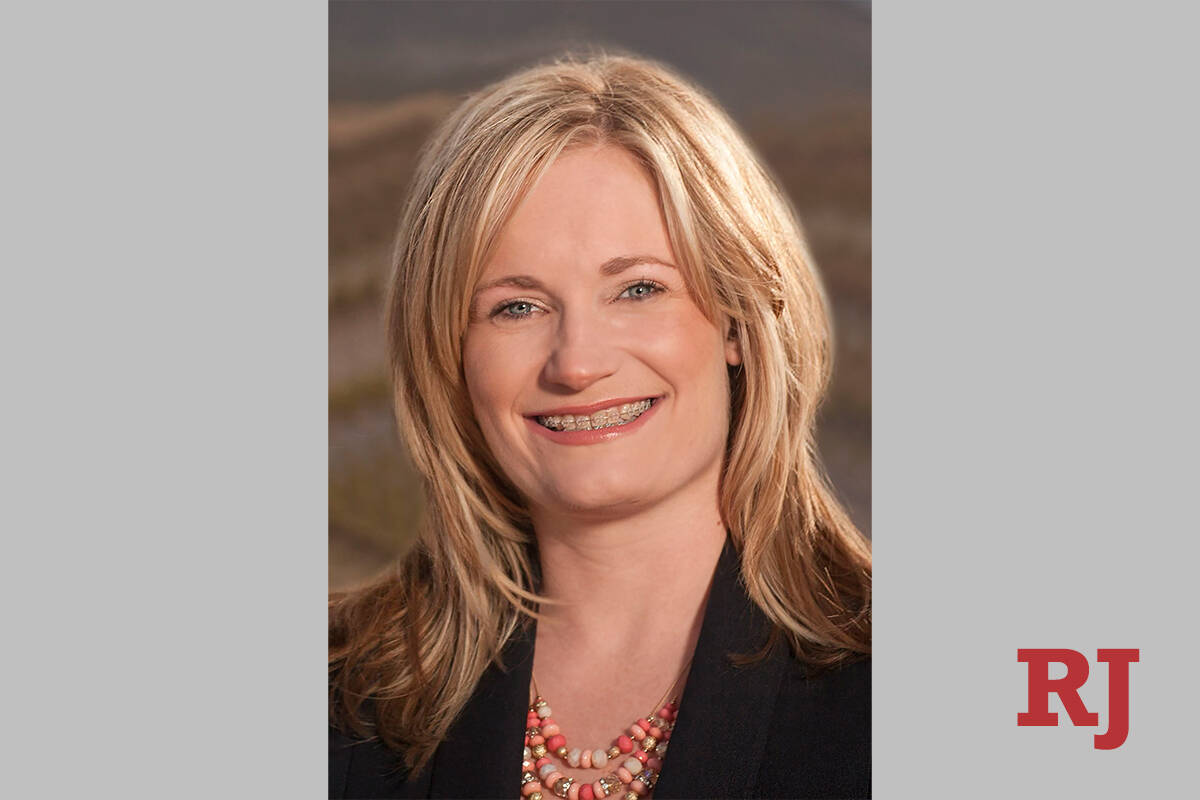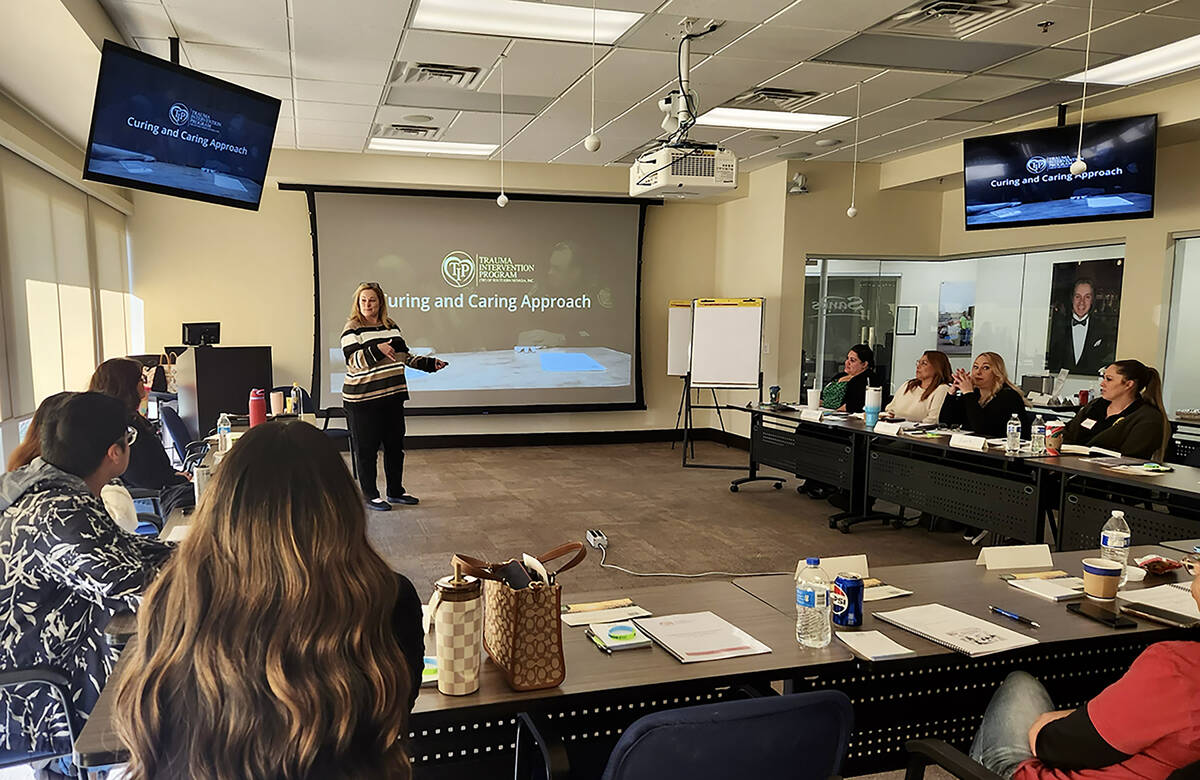Offering ‘emotional first aid’ to people in shock over a sudden death
When first responders in Clark County encounter relatives, friends, co-workers and bystanders upset about a sudden death, they contact volunteers of the Trauma Intervention Program of Southern Nevada to come to the scene.
TIP’s trained helpers were sent to console those in distress about the two Nevada State Police troopers killed by a passing motorist on Nov. 30 and the three faculty members slain by an active shooter on the campus on Dec. 6, according to its chief executive officer Jill Roberts.
“So with the troopers, we had a volunteer that initially responded to NSPS headquarters to provide support,” Roberts said. “And we sent volunteers out with each of the troopers who were going to make death notifications to the families.”
The two state troopers were standing on the D Street off-ramp of northbound Interstate 15 early on Nov. 30 when a suspected drunken driver crashed into them. One died at the scene, the other later at a hospital.
On Dec. 6, an armed man entered UNLV’s Beam Hall near the UNLV Student Union and shot and killed three professors, prompting the university to put classrooms into a temporary lockdown.
For the shooting, TIP at first dispatched volunteers to the trauma centers at University Medical Center and Sunrise Hospital and Medical Center but soon diverted them to the Reunification Center inside Las Vegas Convention Center where college students took buses and waited for their parents or others to pick them up, she said.
“We had 10 volunteers that were out there providing support for family members who were trying to find their students and had bussed students there so everyone could find each other, and people who were locked in their classrooms and still in shock and in crisis,” Roberts said. “We were able to provide support to them.”
TIP also sent a volunteer to Desert Springs hospital near UNLV to comfort a few university people who suffered panic attacks and were “very shaken up at the thought of themselves being shot or people they loved,” she said.
‘So many forgotten victims’
The group also assigned some to talk to UNLV police, who encountered the shooter and shot and killed him outside of Beam Hall.
“The next day we sent out volunteers to university police during shift change in the morning and in the evening and made ourselves available along with other emergency response agencies, peer support teams to be able to provide support for those police officers and dispatchers from the university who were involved,” she said.
A TIP volunteer also consoled members of UNLV’s janitorial staff who were there when the shooting unfolded, Roberts said.
“There are so many forgotten victims,” she said. “Everybody thinks about the students, the emergency responders, the teachers, but you know, the maintenance staff, they’re affected, too. And other people as well,” she said.
TIP regularly works directly with emergency responders at accident and crime scenes, to serve as an intermediary between the police and the families or friends so police are able to conduct their business while the volunteers provide the comfort and support, Roberts said.
“They’re the ones that request us,” she said. “They’re the ones that call us out. So when we get dispatched out to somewhere, it is because an emergency responder has called us. Usually by the time our volunteer arrives on that scene the police department is meeting us as our car saying thank you for being there.”
“Even in a natural death where someone dies at home, we’re sending a volunteer out to their home while the police department is doing their investigation, the coroner’s office is coming and picking up the decedent,” she said.
“Our volunteer is able to sit with the family or friends,” she said. “They’re on that scene and be there for them and provide that support. Help encourage them to find what we call a source of strength. What’s gonna help them get through the next 10 minutes.”
The most common scene TIP responds to is a person dying at home and hospitals call TIP to go to emergency rooms to provide support to families after their loved one was transported or died, she said.
TIP holds training for volunteers two to three times a year. It also trains first responders, including dispatchers, nurses and victim’s advocates, in the same things, she said.
“We teach them how to talk to people who are in crisis,” she said. “We teach them how to provide support to each other and peer support and also how to take care of themselves. Because emergency responders, they’re not just robotic. They have their own emotions.”
One local government official who has high praise for TIP is Crystal Patterson, peer support coordinator for North Las Vegas’ first responders.
“The North Las Vegas police and fire departments rely heavily on the Trauma Intervention Program to provide emotional first aid to victims and their families in their darkest moments following a traumatic incident,” Patterson said.
“The volunteers are caring and compassionate, and their passion for helping anyone in crisis is incredible,” she said. “TIP fills a very specific need in the community and is truly an invaluable asset to the entire valley.”
The TIP program originated in California 40 years ago and there are 18 affiliates across the country. In Clark County, next year will be its 30th anniversary. Today, it has a crew of 75 volunteers, including a half dozen UNLV students, Roberts said.
“We average about 5 to 6 calls a day,” she said. “Last year we responded to just under 2,000 scenes here in Clark County.”
Help them find that source of strength
TIP’s people are trained in what to say and do with those in shock over a person’s death, what the group refers to as “emotional first aid,” Roberts said.
“In the immediate aftermath, a lot of the things we’re doing for people is listening, listening to their stories,” she said.
“People want to talk, people want to tell you what’s going on, what their experience was,” she said. “They want to share, they want someone to hear them. And so a lot of it is listening, acknowledging, validating and doing the little things, helping protecting them from the elements or providing bottled water for them. They’re not thinking that they’re dehydrated and need to drink so it can be the little things, tissues, things like that and then providing information.”
That information often includes giving gentle and caring answers to questions about the dead person’s body and what happens after the coroner removes it, Roberts said.
“Our volunteers are very, very well-versed in like (the) coroner process and police process,” Roberts said. “So when people start asking those questions, like where is my loved one going or what’s the next steps, they’re able to help provide that information.”
The goal is to give those mourning someone’s death the sense that they can adjust and return to living their lives, she said.
“A lot of people in crisis have lost their sense of control and what’s going to help them regain a little bit is getting information on what’s taking place, what’s going to help them get through the next two days because at the end of the day, they’re going to be back by themselves.”
“And so one of our roles is to try to help them find that source of strength,” she said. “Of what’s going to help them get through.”
Contact Jeff Burbank at jburbank@reviewjournal.com or 702-383-0382. Follow him @JeffBurbank2 on X.


















